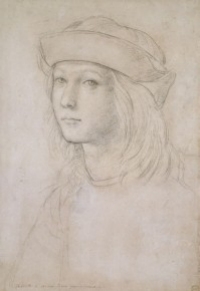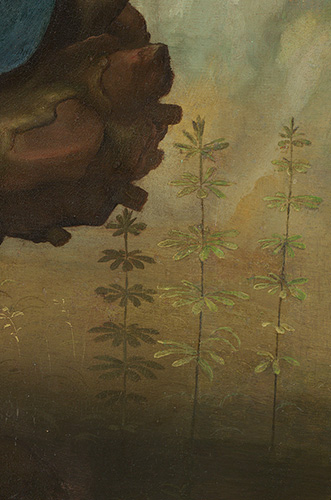
Raphael, Self portrait (chalk heightened with white on paper). Ashmolean Museum, University of Oxford, UK / The Bridgeman Art Library.
Raffaelo di Giovanni Santi was the younger contemporary of Leonardo and Michelangelo, and with them epitomizes the High Renaissance in Italy. For most of the history of Western art, the easy grace and harmonious balance of Raphael’s style has represented an ideal of perfection. A man noted also for wit and charm, he has often been called the “prince of painters.”
Raphael must have studied first with his father, painter at the court of Urbino, an environment rich in the arts and humanist learning. The elder Santi died when the boy was 11. Whether Raphael entered the workshop of Perugino at that time or, as seems more likely, many years later when he was already an acknowledged artist, he quickly mastered Perugino’s delicate, ornamental style, with its open landscapes and gentle figures. It was said that contemporaries had trouble distinguishing Perugino’s work from Raphael’s, but Raphael’s compositions were more sophisticated even when he was a young artist.
Late in 1504, Raphael moved to Florence, drawn there by accounts of Leonardo’s work there. Leonardo’s softly shadowed forms, natural figure groupings, and simplified settings were all stunningly new—and Raphael responded quickly to them. In 1508 the pope called Raphael to Rome. Influenced by the idealized, classical art of the city's ancient past, Raphael’s work took on a new grandeur. He also responded to the more the energetic and physical style of Michelangelo, whose works he had already begun to study in Florence.
Raphael remained in Rome for the last 12 years of his life. In those years he was extremely active, preparing monumental frescoes for the papal chambers, designing tapestries for the Sistine Chapel, and painting scenes that captured mythological stories with delight and exuberance. His work became widely influential through the dissemination of prints. Raphael was also the city’s leading portraitist, creating penetrating psychological images that engaged viewer and sitter with a new intensity. When he died at age 37, the pope ordered that Raphael, who had been keeper of antiquities, be buried in the Pantheon.









